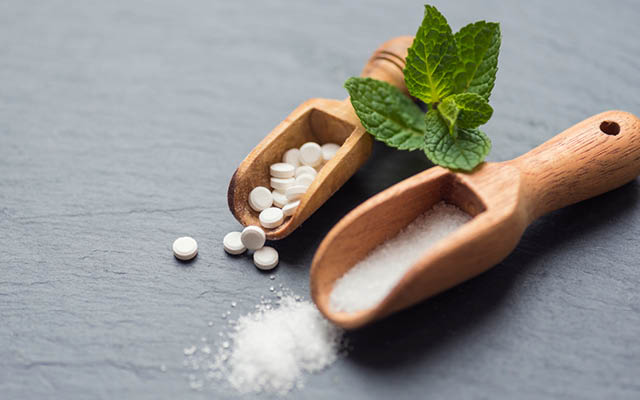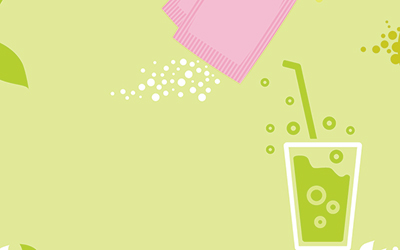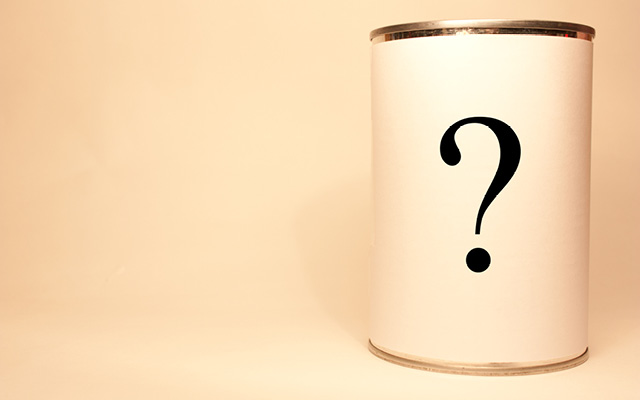At night, when the CEOs of multibillion-dollar companies, like Cargill, Coca-Cola and PepsiCo, drift off to sleep, their dreams may well be sweetened by stevia.
Long considered “the holy grail of sweeteners,” this calorie-free sugar substitute is derived from a plant — which means food companies can market it with the word “natural” and appeal to dieters, diabetics and health-minded folks around the globe.
Unlike some artificial sweeteners, stevia can be used in both liquids and baked goods, meaning it is easy to add to processed foods. Which is why, ever since the FDA loosened restrictions on stevia in 2008, Big Food started sprinkling the white powder into everything from vitamin water to ice cream to bread. From 2010 to 2011 alone, the number of stevia-sweetened foods and beverages on supermarket shelves multiplied ninefold.
“Stevia is a win-win,” says Kristi Michele Crowe, PhD, RD, an assistant professor of nutrition at the University of Alabama and a spokesperson for the Institute of Food Technologists, a consortium of researchers with an interest in food science. “It gives industry a one-size-fits-all sugar substitute, and it meets the low-calorie needs of the consumer.”
Yet many integrative physicians and nutritionists are skeptical of the food industry’s heavy promotion of stevia as a natural and healthy alternative to sugar and artificial sweeteners.
Stevia-derived products like Truvia might be a better choice than Splenda and Equal, such experts say, but they are still highly processed additives that, gram for gram, can be 300 times sweeter than table sugar. Some health experts are worried that consumers dazzled by green-leaf marketing hype have wrongly concluded that commercially processed stevia products are far more natural than they really are. There’s also a growing concern that stevia’s intense sweetness could alter our food preferences.
So while stevia is widely available and generally considered safe, there’s still more for cautious consumers to learn about this sweetener and its impact on our bodies, brains — and taste buds.
From Jungle to Market
The Guarani Indians in Paraguay have used stevia since the 16th century. They discovered that by crushing leaves of a native shrub, Stevia rebaudiana (Bertoni), they could sweeten tea and medicine. By the 1800s, the leaf’s popularity had expanded throughout much of South America.
The mid-20th century saw the debut of artificial sweeteners, like aspartame and saccharin. Food scientists working with stevia isolated the leaf’s sweetest components (called steviol glycosides), and the use of the herb grew, especially in Japan where artificial sweeteners were met with suspicion. Today stevia accounts for 40 percent of that country’s sweetener market.
As the Japanese began to process stevia on a large scale, the U.S. Food and Drug Administration (FDA) took an uncharacteristically hard stance on the substance. The stevia of the ’80s and ’90s was a cruder version of what is seen today, explains Carla Daniels, an FDA spokesperson, and “toxicological testing revealed the possibility of adverse effects with chronic high consumption.” Based on that logic, the agency banned the import of stevia.
Many food-industry watchdogs suspected, however, that the FDA was slow to give its approval because it was capitulating to pressure from companies that had invested millions in developing artificial sweeteners and didn’t want the competition.
Whether it was that pressure or real safety concerns, the sale of stevia remained illegal in the United States until 1995, when the FDA revised its ban. Although stevia was still not an approved food additive and could not legally be called a sweetener, it could be labeled and sold as a dietary supplement.
Meanwhile, behind the scenes, Cargill, PepsiCo and other multinational companies continued to tinker with stevia until they isolated the sweetest and least bitter glycoside: rebaudioside A — or “reb A” for short. The economic and culinary potential of this highly purified extract of stevia was impossible to ignore. When the food companies were ready to take this stevia-derived product to market, they approached the FDA again, this time with GRAS (generally recognized as safe) petitions arguing that their product posed no danger to the public.
To date, the FDA has not objected to the use of reb A by the five Big Food companies that have submitted GRAS notices. The agency has yet to make its own determinations about these products, though it still does not permit the use of whole-leaf stevia or crude stevia extracts in food products.
Natural Halo
There are plenty of popular sweeteners that can claim an all-natural origin — including honey, maple syrup, molasses, and even newcomers like agave and xylitol — but none of them can brag about being calorie free. And there are plenty of artificial sweeteners, like Sweet’N Low and NutraSweet, that are low calorie, but because they are synthetic-based, they cannot claim to be natural.
Stevia’s massive allure, says Catherine Steffen, product spokesperson for Stevia In The Raw, is that until recently, it was the only zero-calorie sugar substitute that could leverage the “natural halo.”
Some experts argue, however, that this halo is a bit tarnished. The process of turning stevia into reb A, they point out, is anything but natural.
In its original, undoctored state, stevia’s molecular makeup triggers the tongue’s taste receptors for both sweet and bitter. But when scientists figured out how to chemically alter stevia, they snipped off the molecule’s less attractive, bitter bits. The result was a solely sweet product — one that’s up to 300 times sweeter than table sugar.
“‘Natural’ used to mean whole, as in holistic,” says Kevin Spelman, PhD, a principal scientist at Herb Pharm, a company that makes herbal extracts. “But the concentrated extraction of one particular fraction of stevia that exists in the little green packet is a far reach from how stevia appears in nature.”
Spelman hasn’t seen anything alarming in the stevia research, and, indeed, the substance has made it over the first safety hurdle in the first world. He does note, though, that oftentimes plants have toxins that are kept in check by other molecules. “Once you extract a molecule from a plant, the plant’s safety profile changes,” says Spelman. “If you extract a single molecule from a plant, you are potentially bypassing the inherent safety mechanism that is typical of whole-plant extracts.”
Sweet Creep
Regardless of whether you take issue with a little molecular malarkey, clearly the industry has a winner on its hands. In 2007, when stevia was marooned on the supplement shelf, Americans spent $2.1 million on the stuff. In 2010, two years after select stevia products were given the green light for inclusion in food and products like Truvia, Stevia In The Raw and Pure Via, sales skyrocketed to $72.5 million. “There was pent-up demand,” says Steffen. “Stevia’s success is nothing short of amazing.”
What is considered “amazing” by industry standards is precisely what concerns some health advocates. “At what point does stevia become another hyper-sweet food additive that distorts people’s food preferences?” asks Kathie Swift, MS, RD, an integrative nutritionist who designs the Food As Medicine program at The Center for Mind-Body Medicine in Washington, D.C. “Sweet-dependency drives many chronic diseases.”
Clearly, our diets are awash in unnaturally sweet foods and beverages. In the United States, at least 15 percent of people regularly use artificial sweeteners, such as aspartame and sucralose, to sweeten their coffee and baked goods. And, millions more buy products sweetened with artificial sweeteners.
“In the context of human history, we haven’t been eating a lot of sugar or other sweeteners for very long — just decades, really,” says Paul Breslin, PhD, a researcher who studies taste perception in the Department of Nutritional Sciences at Rutgers in New Brunswick, N.J. “We don’t know what these dietary changes will do to us in the long run.”
Breslin is concerned about physiological changes sparked by eating a diet that includes additives that are hundreds (or even thousands) of times sweeter than naturally occurring sugars. The body is exquisitely sensitive to sweets, he notes, and receptors in the intestine respond to both sugar and sugarlike substitutes.
When sweetness receptors on the tongue are triggered, the body prepares itself for an onslaught of sugar. Whether or not that sugar ever arrives, our bodies may still release insulin, a powerful hormone with significant biological repercussions for blood sugar and more.
“We respond hormonally to sugars — and possibly high-potency sweeteners — in our mouths. We also have sweetness receptors in the intestines, liver, pancreas and brain,” says Breslin.
That brain-body reaction to sweetness, he explains, is called the cephalic phase response. And it means that, to some extent, whenever you eat anything sweet, your body reacts as though you’ve consumed sugar, regardless of the actual caloric or carbohydrate load.
Stevia advocates, including health experts, point to small-scale studies that suggest stevia does not trigger the same insulin response that sugar and artificial sweeteners do, and may actually improve insulin sensitivity.
Ultimately, though, says Breslin, “we won’t know what all the added sugar and high-potency sweeteners in our diet are doing to us for another 40 or 50 years. Essentially it is a natural experiment on the population, and the jury is still out.”
Moderate Indulgence
Some experts who believe that stevia improves insulin sensitivity think that the sweetener may help those struggling with obesity and diabetes, an increasingly large percentage of the population. Mindy Hamilton-Smith, a dietitian at La Rabida Children’s Hospital in Chicago, recommends stevia because it doesn’t trigger the body’s appetite-stimulating hormones, like ghrelin, she says. But she’s careful to remind her patients that stevia is best used in moderation, because “your palate can change over time with the intensity of a flavor.”
That’s what worries Swift: “I have never been on board with so-called natural sweeteners that are molecularly transformed and enhanced from their biological origins to result in a heightened sweet index.”
Like many, Swift is concerned about the upward spiral of Americans’ taste for sweets. So, instead of steering clients toward stevia, she encourages people to take a “sweet retreat” from all added sweeteners to reawaken the body’s ability to taste the subtle and nuanced sweet notes found in whole foods, such as fruit, sweet potatoes and even green veggies, such as fresh snap peas.
That’s good advice for anyone trying to get their cravings or sugar intake under control. But what about healthy eaters who just want to enjoy an occasional sweet treat? Is stevia really any more or less problematic than sugar?
Many experts agree that if you are satisfying your sweet tooth only once in a while, you can probably go ahead and enjoy whatever naturally sourced sweetener you prefer. After all, they say, eating for pleasure is a big part of experiencing food.
Jacob Teitelbaum, MD, the author of Beat Sugar Addiction Now!, adds: “Ultimately, an argument can be made that one’s sweet tooth should not be indulged, [but] I prefer to indulge it in ways that minimize the impact on the body’s biology, and if that means indulging in a little stevia now and again, so be it.”
From Leaf to Packet
While not all stevia manufacturers use the same “recipe,” these are the basic steps by which stevia is transformed into its popular powdered form.
Step 1: Leaves of Stevia rebaudiana are harvested and dried.
Step 2: Ground leaves are mixed with water during a water extraction process.
Step 3: Extract is filtered and chemically altered to isolate rebaudioside A. The amount of reb A is what distinguishes one stevia-based sweetener from another. A higher reb A content means a sweeter taste and fewer bitter notes. The highest-quality stevia products are 95 percent or more reb A.
Step 4: The extracts are spray-dried and ground to create a powder. (Stevia also comes in liquid and tablet form.)
Step 5: The powder is mixed with a bulking agent. Because stevia is so much sweeter than sugar, manufacturers combine stevia with cornstarch and other natural fillers to create enough volume that the product can be poured easily into tea or coffee.
Step 6: Stevia-based sweetener is packaged and sent to a restaurant or grocery store near you.




This Post Has 0 Comments